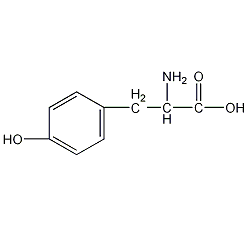
Structural formula
| Business number | 01B2 |
|---|---|
| Molecular formula | C9H11NO3 |
| Molecular weight | 181.19 |
| label |
(S)-2-Amino-3-(4-hydroxyphenyl)propionic acid, β-(p-Hydroxyphenyl)alanine, amino acid drugs, intermediates, Biochemical reagents |
Numbering system
CAS number:60-18-4
MDL number:MFCD00002606
EINECS number:200-460-4
RTECS number:YP2275600
BRN number:392441
PubChem number:24900164
Physical property data
1. Properties: white shiny fine needle-like crystals.
2. Density (g/mL, 25/4℃): 1.333
3. Relative vapor density (g/mL, air=1): Undetermined
4. Melting point (ºC): Decomposes at 342~344℃
5. Boiling point (ºC, normal pressure): Undetermined
6. Boiling point (ºC, 5.2kPa ): Undetermined
7. Refractive index: Undetermined
8. Flash point (ºC): Undetermined
9. Specific rotation (º) : [α]D22 -10.6° (C=4, in 1mol/L hydrochloric acid), [α]D18 -13.2° (C=4, in 3mol/L sodium hydroxide solution)
10. Autoignition point or ignition temperature (ºC): Undetermined
11 . Vapor pressure (kPa, 25ºC): Undetermined
12. Saturated vapor pressure (kPa, 60ºC): Undetermined
13. Heat of combustion (KJ/mol): Undetermined
14. Critical temperature (ºC): Undetermined
15. Critical pressure (KPa): Undetermined
16. Oil and water (octanol/water) Log value of partition coefficient: Undetermined
17. Explosion upper limit (%, V/V): Undetermined
18. Explosion lower limit (%, V/V): Undetermined
19. Solubility: Soluble in acid and alkali solutions, slightly soluble in water, insoluble in absolute ethanol, ether and acetone.
Toxicological data
1. Acute toxicity: Mouse abdominal LC50: >1450mg/kg 2. Other multiple dose toxicity: Rat oral TDLo: 42mg/kg/2W-C 3. Reproductive toxicity: Female rat oral TDLo: 20750mg/kg, Conception occurs after 15-19 days; oral TDLo for female rats: 5 mg/kg, conception occurs after 11-20 days; conception after oral TDLo for female rats: 3500 mg/kg, conception occurs after 15-21 days; TDLo for female mice subcutaneously: 150 mg/kg, Mating 3 days before; oral TDLo for female rabbits: 3mg/kg, conception after 29-31 days 4. Mutagenicity: sister chromatids exchangeTEST system: human lymphocytes: 10mg/L
Ecological data
None yet
Molecular structure data
1. Molar refractive index: 47.37
2. Molar volume (cm3/mol): 135.8
3. Isotonic specific volume (90.2K ): 386.8
4. Surface tension (dyne/cm): 65.7
5. Polarizability (10-24cm3): 18.78
Compute chemical data
1. Reference value for hydrophobic parameter calculation (XlogP): None
2. Number of hydrogen bond donors: 3
3. Number of hydrogen bond acceptors: 4
4. Number of rotatable chemical bonds: 3
5. Interaction��Number of isomers: 2
6. Topological molecule polar surface area 83.6
7. Number of heavy atoms: 13
8. Surface charge: 0
9. Complexity: 176
10. Number of isotope atoms: 0
11. Determine the number of atomic stereocenters: 1
12. Uncertain number of atomic stereocenters: 0
13. Determined number of chemical bond stereocenters: 0
14. Uncertain number of chemical bond stereocenters: 0
15. Number of covalent bond units: 1
Properties and stability
1. Found in tobacco leaves.
Storage method
This product should be sealed and stored away from light.
Synthesis method
1. Extraction method.

2.Direct fermentation method
![]()
3.Enzymatic method

4. Tobacco : BU, 22; FC, 21.
Purpose
1. Biochemical research. Standard for determination of nitrogen in amino acids. Prepare tissue culture medium. Colorimetric quantitative analysis was performed using the Milon reaction (protein color reaction).
2.Raw materials for amino acid infusion and amino acid compound preparations, used as nutritional supplements. Treat poliomyelitis, nuclear encephalitis, hyperthyroidism and other diseases. It is also used as a raw material for the manufacture of diiodotyrosine, dibromotyrosine and L-dopa.

 微信扫一扫打赏
微信扫一扫打赏

